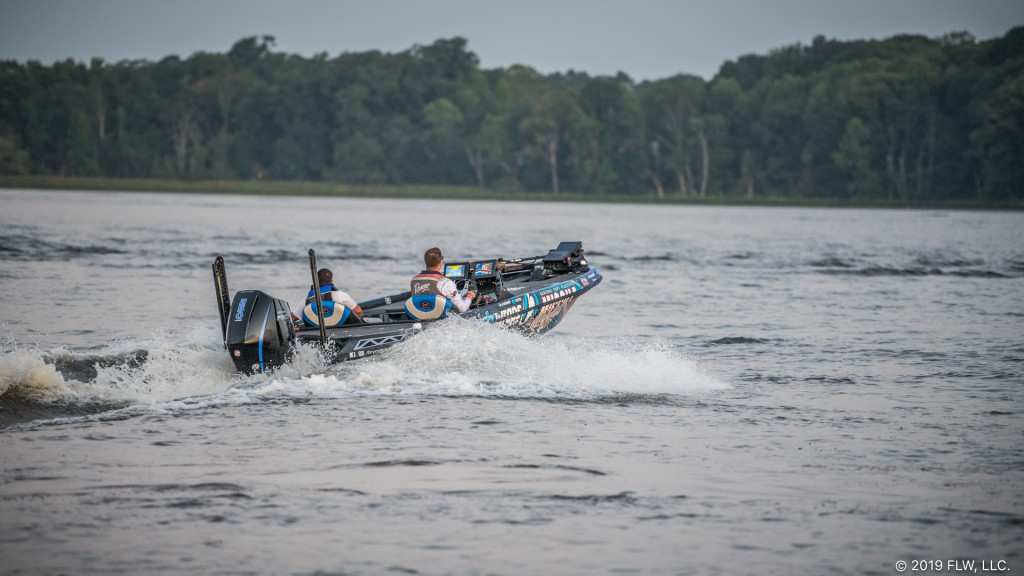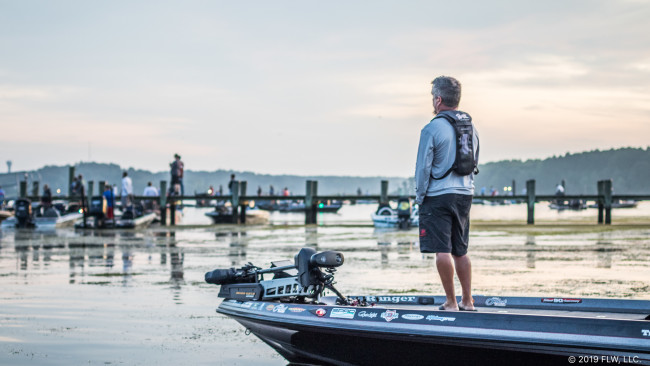Underway on the Potomac
Stop No. 2 of the Costa FLW Series Northern Division gets going on the tidal fishery

The second stop of the Costa FLW Series Northern Division presented by Gajo Baits is underway on the Potomac River. The tournament, which is presented by Lowrance, started off this morning under clear and not altogether uncomfortable conditions after a second consecutive evening of scattered thundershowers. Though fishing has been tough for many in practice, changing conditions could well improve the bite, and the second event of the season will go a long way toward clarifying the Angler of the Year race heading into the finale at the St. Lawrence River.

About the fishery
Running roughly north to south, the Potomac is a major tributary of the Chesapeake Bay. Up above Washington, D.C., the river is shallow, rocky and home to some smallmouths – below that, the tides begin to take effect and the river broadens out. Where most tournaments are won, from about D.C. in the north to Potomac Creek in the south, there is a healthy population of largemouths living anywhere from the very backs of creeks to the grass beds smack on the main river.

Current conditions
After a few blazing hot weeks, the water temperature is up into the high 80s through most of the river. In addition to the hot water, the grass is quite different than it usually is. In most years, the grass is a mix of hydrilla and milfoil, but this year it’s predominantly hydrilla, with some star grass mixed in. The hydrilla is really thick in some areas, but not necessarily in all the usual places.
“The weed growth right now is the worst I’ve seen it in years,” says Ed Casey of Whiteford, Md. “It’s smothered out a lot of the bays. I’ve never seen it this thick or this hard to fish, and I’ve been fishing here since I was 16 years old.”
Casey Smith, who won the Costa FLW Series event on the Potomac in 2016, says the dominance of hydrilla has made fishing pretty tough.
“There’s no milfoil at all, I haven’t seen one blade of it,” relays Smith. “The only thing out there is hydrilla and star grass. The hydrilla is so thick that they just bury in it. It’s very difficult to get to them and I think the feeding windows are much shorter. You might have an hour window of a really good bite in June, but with it this hot and finicky I think it is like 10 minutes. I think the majority of the feeding is probably at night or early morning.”
For the tournament, the wind isn’t forecast to be too strong any day, and the tides will be fairly standard, but not ideal from a timing standpoint. Today, low tide was at 6:15 a.m., and low tide on Saturday will be at 8:15. That means that pros will mostly be fishing a rising tide through the tournament, with the best windows likely coming early on Friday and Saturday.
Two factors could mix things up over the next few days, which may be a good thing considering the tough practice. The first is the potential for some freshly muddied water from the scattered thunderstorms – depending on how the rain fell, there’s a chance some of the creeks could have gotten pretty muddied up. The second is likely all positive – there’s a cooldown on the way. The high for Friday is in the upper 70s, and the high for Saturday is in the low 80s. We’ll see what happens, but cooler weather should make things more comfortable for both the bass and the anglers.

Tactics in play
Because of the Potomac’s famous grass, most of the techniques in play usually center around that. Frogs, flipping plastics, swim jigs and vibrating jigs will always get a lot of play. With how thick the hydrilla is in many places this week, heavier weights than usual will be on deck in many cases.
Some crankbaits and the like will see action on rock, docks, wood and in current, but the other thing to really keep an eye on is finesse. A drop-shot can be deadly both in and out of grass on the Potomac, and a wacky rig or a weightless Senko has been known to catch a pile of bass when things are tough.

Critical factors
- Generating bites – If the fishing is as tough as the pros seem to think it will be, just getting five decent bites could be key.
- Timing – Smith’s assertion that the bite windows are small will mean that making the most of them will be absolutely critical.
- Playing the crowds – The Potomac usually fishes pretty tight, and finding an area to milk that everyone else isn’t in on might go a long way.

Dock talk
Overall, the fishing seems to have been fairly tough in practice. Sure, some folks have had some solid days, but nearly everyone also has a day to report when they really stubbed their toe.
On the low side is Joseph Thompson, who nearly won the T-H Marine Bass Fishing League (BFL) All-American on the Potomac this spring.
“I think 32 to 34 pounds could win this,” says Thompson. “I could be really wrong, but you could catch them one day and the next day catch 6 pounds.”
“It’s been a really slow bite,” says Casey, who’s prediction is about on par. “I think you’re probably going to need around 15 pounds a day. I may be a little heavy on that, but last week 15-2 won the BFL, and a buddy tournament out of Aquia took a little over 16 pounds to win.”
“It’s not nearly as good as 2016, and I think it’s tougher than the 2017 tournament,” says Smith. “I haven’t seen any upper end quality, I think 14 pounds a day is going to do really, really good.”
With a few more days of practice under his belt than he had earlier in the week, Kurt Mitchell still thinks 15 pounds a day is the mark to shoot for.
“It’s not that bad,” says Mitchell. “There’s so many 3-pounders in this place, it’s hard to believe someone can’t catch five a day somehow.”
Tournament details
Format: All boaters and co-anglers will compete for two days. The top 10 boaters and co-anglers based on cumulative weight after two days of competition will advance to the third and final round, with the winner in each division determined by the heaviest cumulative three-day weight.
Takeoff Time: 6:30 a.m. ET
Takeoff Location: Smallwood State Park, 2750 Sweden Point Road, Marbury, Md.
Weigh-In Time: 2:30 p.m. ET
Weigh-In Location: Smallwood State Park